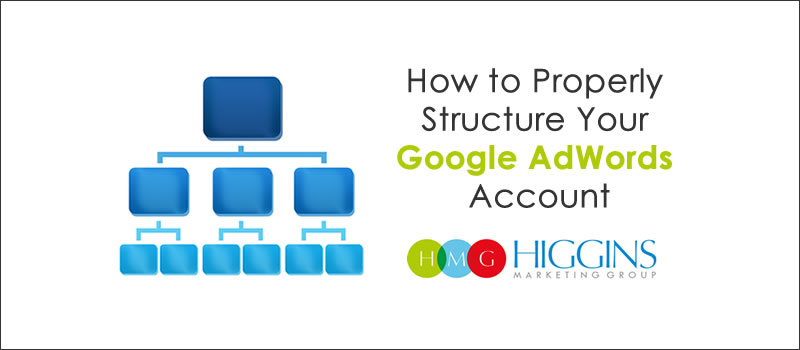Properly Structuring Your AdWords Account
Today, I kick off a new series of posts related to one of my favorite topics, Google AdWords. In my opinion, Google AdWords is the most powerful and flexible advertising tool that has ever existed for small business. That’s a big statement, I know. For a little more on why I believe this, check out why I love Google AdWords
But here’s the thing… just because AdWords is a great tool, doesn’t mean it always delivers great results. Let me offer a quick example to help make my point.
A basketball in my hands is worth about 20 bucks.
A basketball in LeBron James’ hands is worth 21.6 million dollars per year.

I know, it’s a pretty extreme example. However, the very same thing is at play when it comes to using AdWords. AdWords is a TOOL of the trade, just like a basketball is a TOOL of the trade. Whether in sports or in business, your level of success is primarily determined by your level of competence.
That’s where the potential problem surfaces. If you don’t know what you’re doing, Google makes it super-fast and super-easy to blow a lot of money. This rarely takes the form of a “huge mistake,” like waking up one morning and finding you just spent $10,000 trying to sell snow blowers to people in Jamaica. Nope. Google does a good job making budgeting very easy and transparent. Instead, the problem most often takes the form of these two things:
- Over time, wasting 30%+ of your budget due to common mistakes/oversights.
- Failing to leverage some powerful aspects of the AdWord’s platform (things like negative keywords, manual CPC bidding strategies, display network advertising, remarketing, and conversion tracking).
Honestly, to address all these things is beyond the scope of a few blog posts. There are just too many strategies and options. So here’s how I approached it… Before writing this series I forced myself to answer this question:
“If I could only share 5 things to help someone be more successful with AdWords, what would they be?”
Here’s where I ended up.
- How to Position Yourself for Success by Properly Structuring Your Account
- How to Develop High Quality Keyword Lists, Including Negative Keywords
- How to Write Compelling Text Ads and Improve Them Based on Results
- How to Generate More Leads by Using Targeted Landing Pages
- How to Increase AdWords ROI by Tracking Conversion
So let’s dig right into this week’s topic:
How to Properly Structure Your AdWords Account
 One of the most common mistakes I see in clients’ accounts is lack of proper structure. Without properly organizing your account by considering both AdWords’ functionality and your unique business, it’s really impossible to fully optimize your account and get the most bang for your buck. If your budget is tight, this is especially important.
One of the most common mistakes I see in clients’ accounts is lack of proper structure. Without properly organizing your account by considering both AdWords’ functionality and your unique business, it’s really impossible to fully optimize your account and get the most bang for your buck. If your budget is tight, this is especially important.
So what should you do? Here 3 basic guidelines that will help:
1) Map it out on paper first, thinking broad themes to narrow themes
At the highest level, you’ll want to create multiple campaigns. Creating multiple campaigns is important because several critical things are controlled at the campaign level – things like the locations and languages you’d like to target, which network you’d like to use (search or display), which devices you’d like to target (pc, tablet, mobile), and BUDGET.
We recommend creating different campaigns to capture your broad product/service categories, different geographic regions you’d like to target, or both. We also always advise that you always separate your search efforts and your display network efforts into different campaigns as well.
For each campaign, you’ll now want to create multiple ad groups. Each ad group is related to your broader campaign theme, but they should be much more granular. In fact, the more granular the better. It’s at this level where you will be defining your keywords and creating the actual ads that folks will see.
Here’s an example of a properly designed (yet basic) account structure.

2) Limit the scope of each ad group
When in doubt, it’s better to have more ad groups than fewer. Your account will perform better if you have a narrow focus at this level, and define this focus through just a handful of highly related keywords. I’ve seen others say that using 20-30 keywords per ad group is optimal, but this has not been the case based on our experience. HMG recommends limiting each ad group to around 10 tightly related keyword phrases. This makes it much easier to design ads that are highly related to the search terms people are using. It also increases click-through-rate, quality score… and in most cases, conversion rates on your site. All very good things!
3) Create 2 ads for each ad group
For each ad group, we recommend ALWAYS creating two text ads – no more, no less. This allows you to easily split test the effectiveness of your ads over time. Some may advise creating more than two ads per ad group, but we’ve found that continual focus on just two allows you to better isolate the REASONS for the performance differences. It also makes it easier to establish a quick and easy process for improving ad performance over time. (We’ll talk more about split testing strategies in the third post in this series).
Hope this it helps…
For more information on properly structuring your account, check out this page from Google’s AdWords Learning Center: https://support.google.com/adwords/answer/2375470?hl=en
Next week we’ll move on to the topic of creating a solid keyword list, including match types and the importance of identifying negative keywords.

